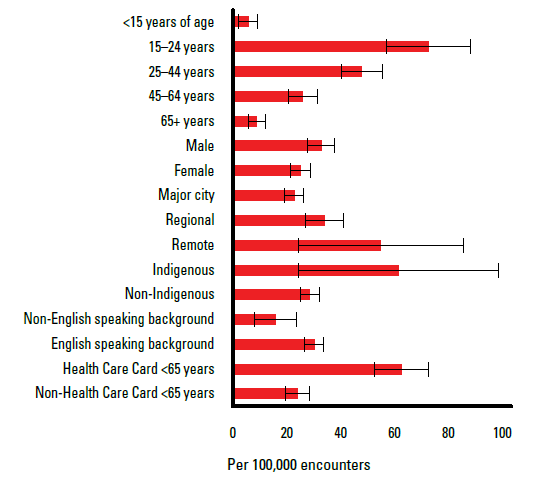Figure 1 shows the patient characteristic-specific rate of SRCs. Patients aged 15–24 years had the highest likelihood of having an SRC, followed by those aged 25–44 years. Patients from regional areas were more likely to have an SRC than those from major cities, as were those from an English-speaking background (compared with those from a non-English-speaking background). We used Commonwealth health care card (CHCC) status in patients aged less than 65 years as a proxy for socio-economic status (SES). Patients aged less than 65 years with a CHCC were more likely to have an SRC than those without a CHCC. Estimated rate of SRCs with Indigenous patients was twice that of non-Indigenous patients; however, this difference was not statistically significant.

Figure 1. Suicide-related contacts per 100 000 encounters
(Error bars indicate 95% confidence intervals)
Patients at SRCs had high rates of referrals with 42.4% (95% confidence intervals [CI]: 37.4–47.3) of patients receiving at least one referral. This is three times the average (13.3%) at all encounters 2011–12.1 Nearly one-third (31.8%) received a psychological referral (eg. psychiatrist, psychologist, mental health team) and 6.9% received a referral to either a hospital or emergency department. Half (51.0%) the patients at SRCs received psychological counselling from the GP.
We have shown that certain patient groups, such as the young, rural and low SES, are more likely to present with an SRC in general practice. However, this study probably only identified a fraction of the true number of SRCs in general practice, as they may often be seen under broader mental health labels (such as depression).
Provenance and peer review: Commissioned; not peer reviewed.
Acknowledgements
The authors thank the GP participants in the BEACH program and all members of the BEACH team. Financial contributors to BEACH between 1998 and 2013: Abbott Australasia; AstraZeneca Pty Ltd (Australia); Department of Health and Ageing, Australian Government; Department of Veterans’ Affairs, Australian Government; Australian Institute of Health and Welfare; Aventis Pharma Pty Ltd; Bayer Australia Ltd; CSL Biotherapies Australia Pty Ltd; GlaxoSmithKline Australia Pty Ltd; Janssen-Cilag Pty Ltd; Merck, Sharpe and Dohme (Australia) Pty Ltd; National Occupational Health and Safety Commission; National Prescribing Service; Novartis Pharmaceuticals Australia Pty Ltd; Pfizer Australia; Roche Products Pty Ltd; Sanofi-Aventis Australia Pty Ltd; Wyeth Australia Pty Ltd.